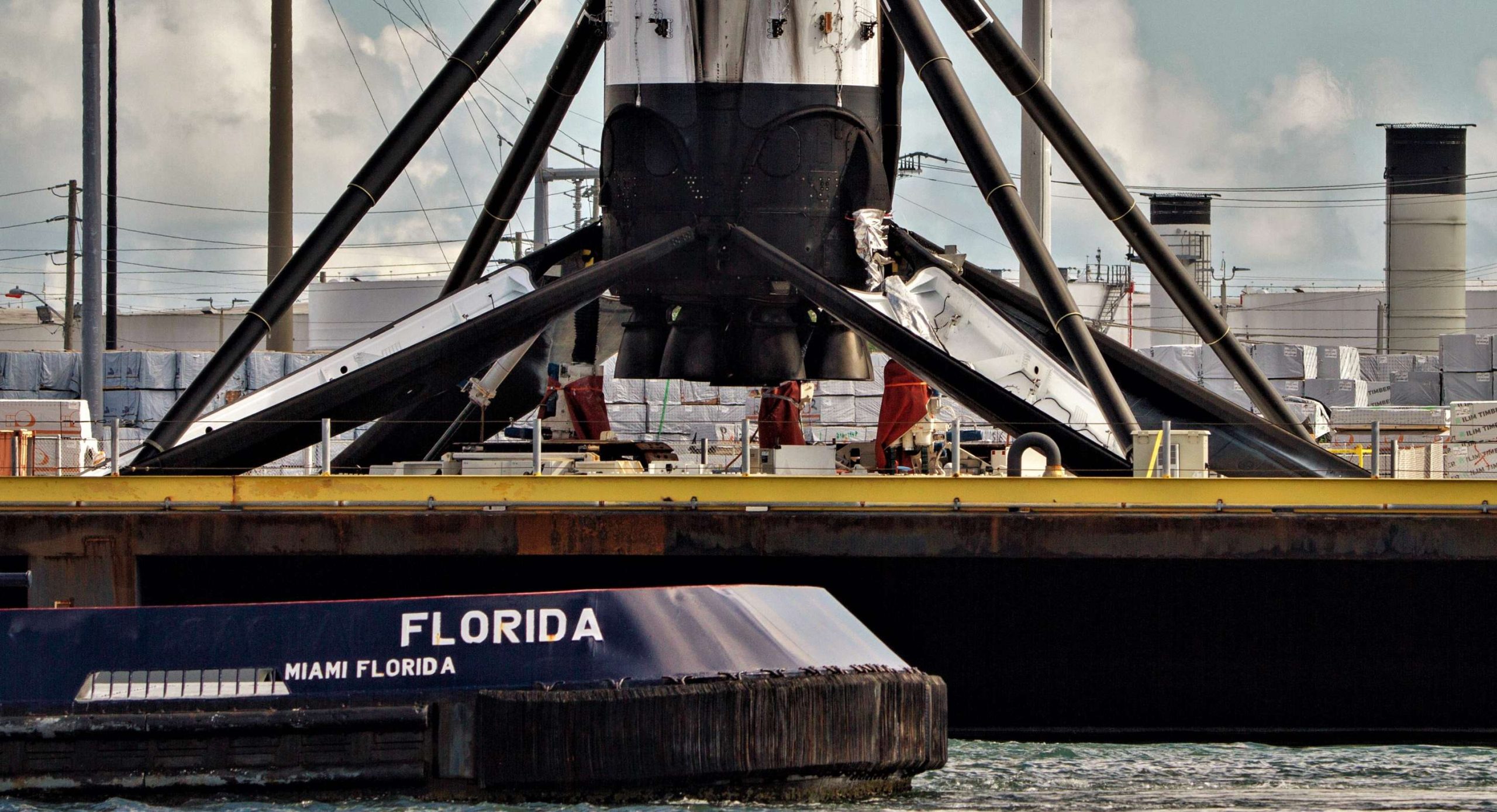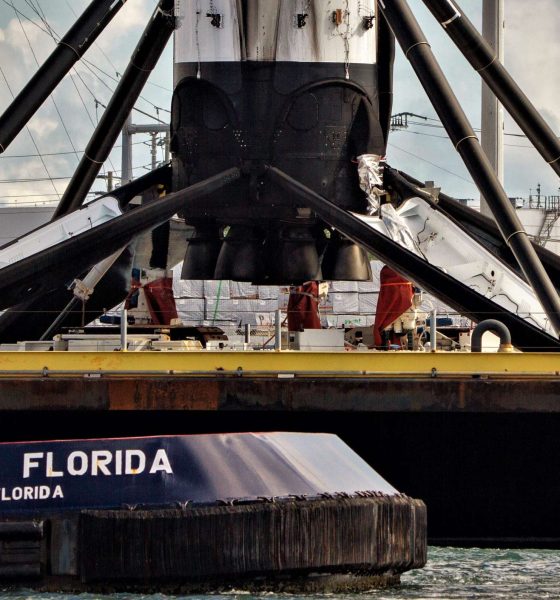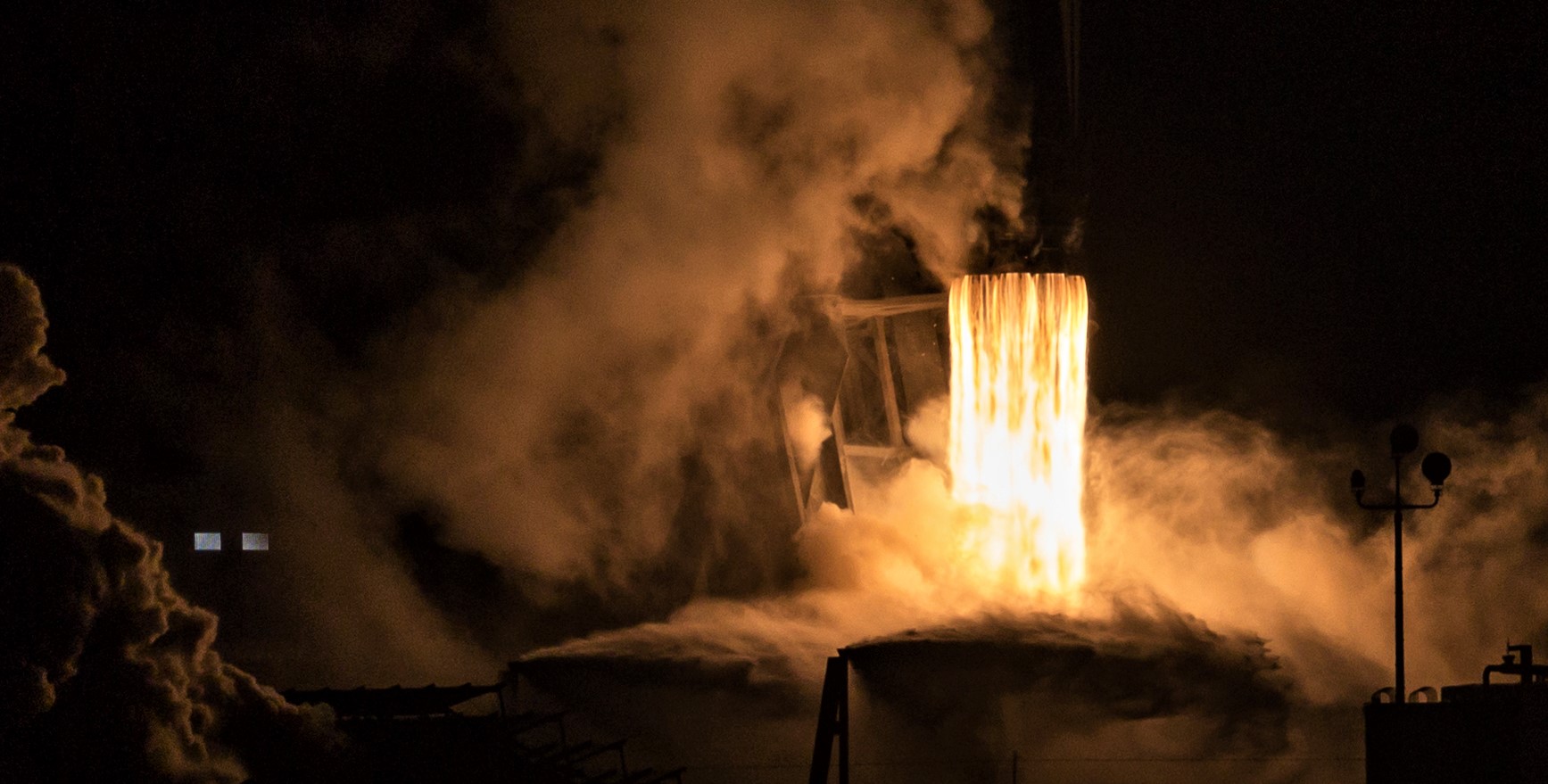

News
SpaceX Falcon 9 Block 5 booster sails into port aboard OCISLY after launch #2
SpaceX’s second Falcon 9 Block 5 booster, core B1047, has returned once more to Port Canaveral, Florida aboard drone ship Of Course I Still Love You (OCISLY) after a successful flight-proven launch, placing commercial communications satellite Es’hail-2 into a healthy, high-energy orbit.
SpaceX’s third reuse of a Block 5 booster since the upgraded Falcon 9 version’s May 2018 debut, the November 15 launch marks the company’s 11th mission to launch on a flight-proven rocket in 2018 alone, more than 60% of the 18 missions completed thus far.
As seen from Exploration Tower, #SpaceX #Falcon9 B1047.2 begins docking at Port Canaveral. pic.twitter.com/bDB83Va9Lg
— John Kraus (@johnkrausphotos) November 19, 2018
Prior to launching Es’hailsat’s Es’hail-2 satellite, Falcon 9 B1047 placed the massive ~7000 kg (15,500 lb) Telstar 19V communications satellite into orbit while also marking the second successful launch of Falcon 9’s Block 5 iteration. Nearly a new rocket, Block 5 focused on dramatically improving the reliability and reusability of the workhorse Falcon 9 rocket, ultimately translating into the total redesign and replacement of a large number of major subsystems.
The changes range from a totally new octaweb thrust structure (bolted, rather than welded, together), a clean-sweep upgrade of first and second stage avionics, new helium and nitrogen pressure vessels (COPVs), a total revamp of thermal protection for the interstage, legs, and octaweb, significantly refined Merlin 1D sea level and vacuum engines, Fairing 2.0, and much, much more. With the extensive changes brought by Block 5, SpaceX engineers strove to fully eradicate or at least cushion several unlikely but possible failure modes while also increasing the overall usable lifespan of particularly flight-critical, wear-intensive systems and components.

How many layers of soot?
Although it’s clear that some distance must still be covered before the specific goals of Block 5 can be realized, the aspiration of the design is to enable as many as 10 booster reuses with little more than thorough inspections between launches, and perhaps 100 or more launches per booster with more extensive maintenance and repairs every 10 or so launches.
The first unprecedented step in that direction – for Falcon 9 Block 5, at least – will be the third launch of a specific booster, a feat SpaceX was not willing to attempt before Block 5’s introduction. That milestone third launch was actually meant to occur on Monday, November 19 but has since been delayed to give SpaceX time to perform additional preflight inspections of Falcon 9, be it the twice-flown booster, the upper stage, the payload fairing, or all of the above.
The #SpaceX booster being moved into place at the dock in #PortCanaveral #Falcon9 pic.twitter.com/wdbwIRWeyh
— Tom (@Cygnusx112) November 19, 2018
Given just how critical a step the launch will be for SpaceX’s long-term goal of fielding rockets with aircraft-like reusability, caution is particularly key in this case, as any partial or total failure will almost instantly soil multi-flight Falcon 9 boosters in the eyes of a number of launch customers, potentially leading customers to request launches on boosters that have previously flown less than twice. Even then, a 5-7 day delay can be extremely unsavory for many customers, as time is very frequently money for satellite operators – a satellite on the ground is essentially a black hole that devours capital and generates zero revenue, sort of like a nuclear reactor that hasn’t been connected to the grid.
B1047’s successful return to port after a second operational launch will serve as another valuable wealth of data that can be used to further optimize SpaceX’s understanding of Falcon 9 Block 5 and its capabilities.

News
Tesla FSD fleet is nearing 7 billion total miles, including 2.5 billion city miles
As can be seen on Tesla’s official FSD webpage, vehicles equipped with the system have now navigated over 6.99 billion miles.

Tesla’s Full Self-Driving (Supervised) fleet is closing in on almost 7 billion total miles driven, as per data posted by the company on its official FSD webpage.
These figures hint at the massive scale of data fueling Tesla’s rapid FSD improvements, which have been quite notable as of late.
FSD mileage milestones
As can be seen on Tesla’s official FSD webpage, vehicles equipped with the system have now navigated over 6.99 billion miles. Tesla owner and avid FSD tester Whole Mars Catalog also shared a screenshot indicating that from the nearly 7 billion miles traveled by the FSD fleet, more than 2.5 billion miles were driven inside cities.
City miles are particularly valuable for complex urban scenarios like unprotected turns, pedestrian interactions, and traffic lights. This is also the difference-maker for FSD, as only complex solutions, such as Waymo’s self-driving taxis, operate similarly on inner-city streets. And even then, incidents such as the San Francisco blackouts have proven challenging for sensor-rich vehicles like Waymos.
Tesla’s data edge
Tesla has a number of advantages in the autonomous vehicle sector, one of which is the size of its fleet and the number of vehicles training FSD on real-world roads. Tesla’s nearly 7 billion FSD miles then allow the company to roll out updates that make its vehicles behave like they are being driven by experienced drivers, even if they are operating on their own.
So notable are Tesla’s improvements to FSD that NVIDIA Director of Robotics Jim Fan, after experiencing FSD v14, noted that the system is the first AI that passes what he described as a “Physical Turing Test.”
“Despite knowing exactly how robot learning works, I still find it magical watching the steering wheel turn by itself. First it feels surreal, next it becomes routine. Then, like the smartphone, taking it away actively hurts. This is how humanity gets rewired and glued to god-like technologies,” Fan wrote in a post on X.
News
Tesla starts showing how FSD will change lives in Europe
Local officials tested the system on narrow country roads and were impressed by FSD’s smooth, human-like driving, with some calling the service a game-changer for everyday life in areas that are far from urban centers.

Tesla has launched Europe’s first public shuttle service using Full Self-Driving (Supervised) in the rural Eifelkreis Bitburg-Prüm region of Germany, demonstrating how the technology can restore independence and mobility for people who struggle with limited transport options.
Local officials tested the system on narrow country roads and were impressed by FSD’s smooth, human-like driving, with some calling the service a game-changer for everyday life in areas that are far from urban centers.
Officials see real impact on rural residents
Arzfeld Mayor Johannes Kuhl and District Administrator Andreas Kruppert personally tested the Tesla shuttle service. This allowed them to see just how well FSD navigated winding lanes and rural roads confidently. Kruppert said, “Autonomous driving sounds like science fiction to many, but we simply see here that it works totally well in rural regions too.” Kuhl, for his part, also noted that FSD “feels like a very experienced driver.”
The pilot complements the area’s “Citizen Bus” program, which provides on-demand rides for elderly residents who can no longer drive themselves. Tesla Europe shared a video of a demonstration of the service, highlighting how FSD gives people their freedom back, even in places where public transport is not as prevalent.
What the Ministry for Economic Affairs and Transport says
Rhineland-Palatinate’s Minister Daniela Schmitt supported the project, praising the collaboration that made this “first of its kind in Europe” possible. As per the ministry, the rural rollout for the service shows FSD’s potential beyond major cities, and it delivers tangible benefits like grocery runs, doctor visits, and social connections for isolated residents.
“Reliable and flexible mobility is especially vital in rural areas. With the launch of a shuttle service using self-driving vehicles (FSD supervised) by Tesla in the Eifelkreis Bitburg-Prüm, an innovative pilot project is now getting underway that complements local community bus services. It is the first project of its kind in Europe.
“The result is a real gain for rural mobility: greater accessibility, more flexibility and tangible benefits for everyday life. A strong signal for innovation, cooperation and future-oriented mobility beyond urban centers,” the ministry wrote in a LinkedIn post.
News
Tesla China quietly posts Robotaxi-related job listing
Tesla China is currently seeking a Low Voltage Electrical Engineer to work on circuit board design for the company’s autonomous vehicles.

Tesla has posted a new job listing in Shanghai explicitly tied to its Robotaxi program, fueling speculation that the company is preparing to launch its dedicated autonomous ride-hailing service in China.
As noted in the listing, Tesla China is currently seeking a Low Voltage Electrical Engineer to work on circuit board design for the company’s autonomous vehicles.
Robotaxi-specific role
The listing, which was shared on social media platform X by industry watcher @tslaming, suggested that Tesla China is looking to fill the role urgently. The job listing itself specifically mentions that the person hired for the role will be working on the Low Voltage Hardware team, which would design the circuit boards that would serve as the nervous system of the Robotaxi.
Key tasks for the role, as indicated in the job listing, include collaboration with PCB layout, firmware, mechanical, program management, and validation teams, among other responsibilities. The role is based in Shanghai.
China Robotaxi launch
China represents a massive potential market for robotaxis, with its dense urban centers and supportive policies in select cities. Tesla has limited permission to roll out FSD in the country, though despite this, its vehicles have been hailed as among the best in the market when it comes to autonomous features. So far, at least, it appears that China supports Tesla’s FSD and Robotaxi rollout.
This was hinted at in November, when Tesla brought the Cybercab to the 8th China International Import Expo (CIIE) in Shanghai, marking the first time that the autonomous two-seater was brought to the Asia-Pacific region. The vehicle, despite not having a release date in China, received a significant amount of interest among the event’s attendees.








